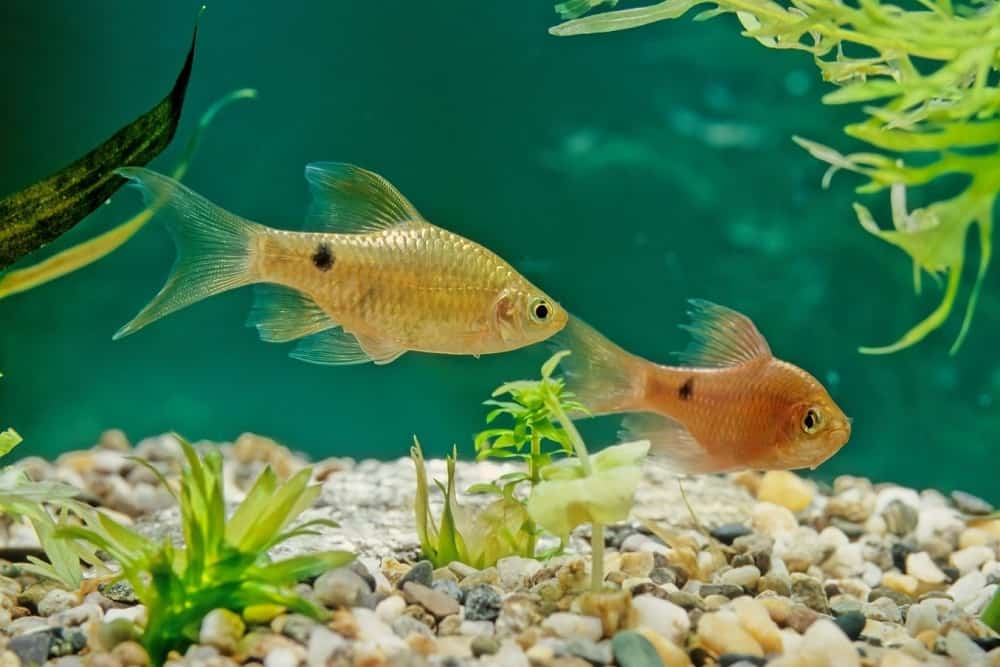The Rosy Barb is a subtropical freshwater species that belongs to the Cyprinidae family. Its scientific name is the Pethia Conchonius and it is commonly found in Southern Asian countries.
As a hardy species, Rosy Barb fish are relatively easy to care for, making them an ideal option for aquarium owners with different levels of experience.

Care Guide
Although Rosy Barbs aren’t an overly demanding species in regards to tank requirements and feeding habits, they do still have certain requirements that need to be met.
Tank Size
Rosy Barbs should be kept in a tank that can hold at least 20 to 30 gallons of water. Of course, the more that you add to the tank, the more space they are going to require.
It is important to remember that Rosy Barb are schooling fish that need to be kept in groups. As a general rule, it is recommended that you allocate at least 5 gallons of water for each fish.
If possible, you should opt for a 30 gallon tank as this is going to provide the fish inside with plenty of space to swim freely and explore. Also, ensure that the lid is secure on the tank as there is a risk of them jumping out of the tank when swimming at speed.
Tank Mates
Rosy Barbs are a sociable species that cope well in a community tank. Their peaceful temperaments mean that they can happily co-exist with many other species. When it comes to establishing the perfect tank setup, you can either keep a single species or mix them with other species that they are compatible with.
These fish can either be added to a tank with other barb species such as the Cherry Barb, or Tiger Barb. Alternatively, they can be kept with Swordtails, American Cichlids, Ropefish, Paradise Fish, Mollies, Neon Tetras, and Gouramis.
Avoid keeping Rosy Barbs with other species that have aggressive or territorial temperaments. It is also worth noting that Rosy Barbs tend to nip the fins of other fish. As such, you shouldn’t keep them with other slow swimming species that have long-flowing fins.
Same Species Tanks
These fish are not a solitary species and do not cope well when kept in a tank alone. If you intend to add some Rosy Barbs to your aquarium you must make sure that you add at least 5. In doing so you will subject them to less stress.
Keeping Rosy Barbs in a group is going to be beneficial for their health and wellbeing. Moreover, Rosy Barbs are less likely to nip fins and show signs of aggression when kept with other members of the same species.
Water Parameters
Whilst Rosy Barbs are a hardy species, they have certain needs when it comes to the temperature, pH, and hardness of the water. In the wild, they are typically found in lakes and fast-moving rivers where the water is slightly warm, however, they are quite tolerant and will adapt pretty well in a tank set up.
The temperature should be between 64 and 79 degrees Fahrenheit although keeping it near the middle around 72 or 74 degrees Fahrenheit is best. The pH level should be between 6 and 8, whilst the water hardness can vary from 4 to 10 KH. They are also receptive to higher nitrate levels.
What To Put In Their Tank
As an inquisitive species, Rosy Barbs enjoy living in a tank that is well-decorated as this will keep them stimulated. They do not tend to spend a lot of time near the bottom of the tank but you may still wish to add a layer of sand or fine-grained gravel substrate as this will help the plants.
You should add plenty of plants making sure that you are cautious about the types that you choose. Rosy Barbs are prone to shredding and nipping the leaves of certain plants especially those with soft leaves. As such it is recommended that you opt for plants with firm leaves. The plants will provide your fish with somewhere to hide too.
You can also add rocks, caves, driftwood, and dim lights. Whilst Rosy Barbs like to live in a decorated tank, do not overcrowd it as they still need room to swim.
A filtration system is also a necessity. Rosy Barbs usually prefer water with high oxygen levels so you should add a filter that is going to add a continuous supply of oxygen to the water.
Common Diseases
Some fish have better immunity to diseases than others. As we have mentioned, Rosy Barbs are a hardy species meaning that they have a pretty good tolerance to diseases.
This does not guarantee that your fish is always going to be in optimal health because some may pick up common diseases that affect the majority of fish species. Ich is a disease that affects many freshwater fish. This parasitic disease is also known as the white spot disease.
These conditions are avoidable so long as the quality of the water is maintained. Ideally, you should try and conduct regular tests on the water.
Food And Diet
Rosy Barbs are omnivorous and keen eaters. In fact, you will find that they eat anything that they are offered. They will eat vegetables and meaty foods as well as frozen foods and live foods.
Feed them foods that contain lots of nutrients and protein. For example, small insects, crustaceans, worms, bloodworms, and brine shrimp are all good options.
Alternatively, you may wish to give them dried food in the form of flakes or pellets. Should you decide to opt for a variety of dried food, you must make sure that you supplement your Rosy Barbs diet with other foods that have a higher nutritional content.
If given the opportunity your Rosy Barb will overeat. To avoid this issue, you should feed them foods that they can consume within two minutes twice a day.
Lifespan
The average lifespan of a Rosy Barb is up to 5 years when cared for correctly. Of course, there is no guarantee as to how long your fish is going to live but when kept in optimal conditions they should live for 5 years and in some cases, possibly longer.
Appearance
Rosy Barbs have a body that is shaped like a tornado with a fork-like tail. Although they may not be overly colorful, these fish have distinct markings that make them an attractive species.
They have transparent fins and reddish-colored bodies with subtle black markings. This color tends to become less prominent when the fish are stressed and more intense during mating.
Size
These are very small fish that measure 6” long and weigh around 12 Oz. When they reach 2.5” long they are considered to be mature.
Behaviour & Temperament
Rosy Barbs are known for their peaceful, non-aggressive temperaments. As they are active and playful they will enjoy swimming around their tank in a group.
Initially, they tend to be quite shy when they are first introduced to a new tank, but over time as they familiarize themselves with their surroundings they tend to become more confident. As mentioned, like many other species they are prone to fine nipping but keeping them in a group with other members of their species will reduce this issue because they are not likely to be as stressed.
Breeding
These fish are pretty easy to breed. It is recommended that you breed the fish separately in a specialized tank that shares the same parameters. They prefer to breed in clean water that is just a few inches deep.
In the breeding tank, you should have one male and two females. The female’s color will become more vibrant when she is ready to breed. The pair will then begin to move around the tank together.
Following this, the eggs are then fertilized and scattered onto the sandy substrate or the plants. Once the eggs have been laid you should remove the pair.
This is because neither of the parents are going to display parental behavior, instead, they will try to eat the eggs. The eggs will then take 30 hours to hatch. To begin they will feed on the egg until they can swim freely. As they begin to grow, you can then remove them to a deeper tank where they remain separated from the adults who are likely to eat them.
Gender Differences: Male vs Female
It is difficult to differentiate between male and female Rosy Barbs when they are young, however, it gets easier as they get older. The females tend to be smaller and fatter and more yellow. The males, on the other hand, are slender with brighter coloring. Moreover, the males have a black patch on their dorsal fin.
Fun Facts
- There are several Rosy Barb subspecies, this includes the gold neon rosy barb, the longfin rosy barb, and a few more.
- The Rosy Barb is often referred to as the Rose Barb or the Red Barb.








